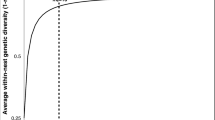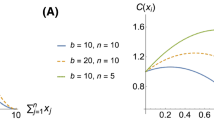Abstract
Division of labour is one of the most prominent features of social insects. The efficient allocation of individuals to different tasks requires dynamic adjustment in response to environmental perturbations. Theoretical models suggest that the colony-level flexibility in responding to external changes and internal perturbation may depend on the within-colony genetic diversity, which is affected by the number of breeding individuals. However, these models have not considered the genetic architecture underlying the propensity of workers to perform the various tasks. Here, we investigated how both within-colony genetic variability (stemming from variation in the number of matings by queens) and the number of genes influencing the stimulus (threshold) for a given task at which workers begin to perform that task jointly influence task allocation efficiency. We used a numerical agent-based model to investigate the situation where workers had to perform either a regulatory task or a foraging task. One hundred generations of artificial selection in populations consisting of 500 colonies revealed that an increased number of matings always improved colony performance, whatever the number of loci encoding the thresholds of the regulatory and foraging tasks. However, the beneficial effect of additional matings was particularly important when the genetic architecture of queens comprised one or a few genes for the foraging task’s threshold. By contrast, a higher number of genes encoding the foraging task reduced colony performance with the detrimental effect being stronger when queens had mated with several males. Finally, the number of genes encoding the threshold for the regulatory task only had a minor effect on colony performance. Overall, our numerical experiments support the importance of mating frequency on efficiency of division of labour and also reveal complex interactions between the number of matings and genetic architecture.



Similar content being viewed by others
References
Bertram SM, Gorelick R, Fewell JH (2003) Colony response to graded resource changes: an analytical model of the influence of genotype, environment, and dominance. Theor Popul Biol 64:151–162
Bonabeau E, Theraulaz G, Deneubourg JL (1996) Quantitative study of the fixed threshold model for the regulation of division of labour in insect societies. Proc R Soc B 263:1565–1569
Boomsma JJ, Ratnieks FLW (1996) Paternity in eusocial hymenoptera. Phil Trans R Soc B 351:947–975
Calabi P, Traniello JFA (1989) Behavioral flexibility in age castes of the ant Pheidole dentata. J Insect Behav 2:663–677
Cerdá X, Angulo E, Boulay R, Lenoir A (2009) Individual and collective foraging decisions: field study of worker recruitment in the gypsy ant. Behav Ecol Sociobiol 63:551–562
Costa JT, Ross KG (2003) Fitness effects of group merging in a social insect. Proc R Soc B 270:1697–1702
Crosland MWJ, Traniello JFA (1997) Behavioral plasticity in division of labor in the lower termite Reticulitermes fukienensis. Naturwissenschaften 84:208–211
DeWitt TJ, Sih A, Wilson DS (1998) Costs and limits of phenotypic plasticity. Trends Ecol Evol 13:77–81
Fewell JH, Bertram SM (1999) Division of labor in a dynamic environment: response by honeybees (Apis mellifera) to graded changes in colony pollen stores. Behav Ecol Sociobiol 46:171–179
Fournier D, Battaille G, Timmermans I, Aron S (2008) Genetic diversity, worker size polymorphism and division of labour in the polyandrous ant Cataglyphis cursor. Behav Ecol Sociobiol 75:151–168
Frumhoff PC, Baker J (1988) A genetic component to division of labour within honey bee colonies. Nature 333:358–361
Fuchs S, Schade V (1994) Lower performance in honeybee colonies of uniform paternity. Apidologie 25:155–168
Gordon DM (1989) Dynamics of task switching in harvester ants. Anim Behav 38:194–204
Gordon DM (1991) Behavioral flexibility and the foraging ecology of seed-eating ants. Am Nat 138:379–411
Graham S, Myerscough MR, Jones JC, Oldroyd BP (2006) Modelling the role of intracolonial genetic diversity on regulation of brood temperature in honey bee (Apis mellifera L.) colonies. Insectes Soc 53:226–232
Hölldobler B, Wilson EO (1990) The ants. Belknap, Cambridge
Hughes WOH, Ratnieks FLW, Oldroyd BP (2008) Multiple paternity or multiple queens: two routes to greater intracolonial genetic diversity in the eusocial hymenoptera. J Evol Biol 21:1090–1095
Hunt GJ, Page RE, Fondrk MK, Dullum CJ (1995) Major quantitative trait loci affecting honey bee foraging behavior. Genetics 141:1537–1545
Jeanson R, Fewell JH, Gorelick R, Bertram SM (2007) Emergence of increased division of labor as a function of group size. Behav Ecol Sociobiol 62:289–298
Jones JC, Nanork P, Oldroyd BP (2007) The role of genetic diversity in nest cooling in a wild honey bee, Apis florea. J Comp Physiol A 193:159–165
Jones JC, Myerscough MR, Graham S, Oldroyd BP (2004) Honey bee nest thermoregulation: diversity promotes stability. Science 305:402–404
Julian GE, Cahan S (1999) Undertaking specialization in the desert leaf-cutter ant Acromyrmex versicolor. Anim Behav 58:437–442
Karsai I, Wenzel JW (2000) Organization and regulation of nest construction behavior in Metapolybia Wasps. J Insect Behav 13:111–140
Keller L, Reeve H (1994) Genetic variability, queen number, and polyandry in social hymenoptera. Evolution 48:694–704
Lenoir JC, Laloi D, Dechaume-Moncharmont FX, Solignac M, Pham MH (2006) Intra-colonial variation of the sting extension response in the honey bee Apis mellifera. Insectes Soc 53:80–85
Mattila HR, Seeley TD (2007) Genetic diversity in honey bee colonies enhances productivity and fitness. Science 317:362–364
Mercier J, Lenoir A (1999) Individual flexibility and choice of foraging strategy in Polyrhachis laboriosa F. Smith (hymenoptera, formicidae). Insectes Soc 46:267–272
Myerscough MR, Oldroyd BP (2004) Simulation models of the role of genetic variability in social insect task allocation. Insectes Soc 51:146–152
O’Donnell S (1996) RAPD markers suggest genotypic effects on forager specialization in a eusocial wasp. Behav Ecol Sociobiol 38:83–88
Oldroyd BP, Rinderer TE, Buco SM (1991) Intracolonial variance in honey bee foraging behaviour: the effects of sucrose concentration. J Apic Res 30:137–145
Oldroyd BP, Rinderer TE, Buco SM, Beaman LD (1993) Genetic variance in honey bees for preferred foraging distance. Anim Behav 45:323–332
Oldroyd BP, Sylvester HA, Wongsiri S, Rinderer TE (1994) Task specialization in a wild bee, Apis florea (hymenoptera: apidae), revealed by RFLP banding. Behav Ecol Sociobiol 34:25–30
Page RE, Mitchell SD (1998) Self-organization and the evolution of division of labor. Apidologie 29:171–190
Page RE, Fondrk MK, Hunt GJ, Guzmán-Novoa E, Humphries MA, Nguyen K, Greene AS (2000) Genetic dissection of honeybee (Apis mellifera L.) foraging behavior. J Heredity 91:474–479
Perez-Uribe A, Floreano D, Keller L (2003) Effects of group composition and level of selection in the evolution of cooperation in artificial ants. In: Banzhaf W, Christaller T, Dittrich P, Kim J, Ziegler J (eds) Proceedings of the 7th European conference on artificial life (ECAL’03). Springer, New York, pp 128–137
Ranger S, O’Donnell S (1999) Genotypic effects on forager behavior in the neotropical stingless bee Partamona bilineata (Hymenoptera: meliponidae). Naturwissenschaften 86:187–190
Robinson GE (1992) Regulation of division of labor in insect societies. Ann Rev Entomol 37:637–665
Rosset H, Keller L, Chapuisat M (2005) Experimental manipulation of colony genetic diversity had no effect on short-term task efficiency in the Argentine ant Linepithema humile. Behav Ecol Sociobiol 58:87–98
Rüppell O, Pankiw T, Page RE (2004) Pleiotropy, epistasis and new QTL: the genetic architecture of honey bee foraging behavior. J Heredity 95:481–491
Schwander T, Rosset H, Chapuisat M (2005) Division of labour and worker size polymorphism in ant colonies: the impact of social and genetic factors. Anim Behav 59:215–221
Seeley TD (1989) Social foraging in honey bees: how nectar foragers assess their colony’s nutritional status. Behav Ecol Sociobiol 24:181–199
Seeley TD (1995) The wisdom of the hive. Harvard University Press, Cambridge
Snyder LE (1992) The genetics of social behavior in a polygynous ant. Naturwissenschaften 79:525–527
Sokal RR, Rohlf FJ (1995) Biometry: The principles and practice of statistics in biological research. Freeman, New York
Strassmann J (2001) The rarity of multiple mating by females in the social hymenoptera. Insectes Soc 48:1–13
Trontti K, Thurin N, Sundström L, Aron S (2007) Mating for convenience or genetic diversity? Mating patterns in the polygynous ant Plagiolepis pygmaea. Behav Ecol 18:298–303
Waibel M, Floreano D, Magnenat M, Keller L (2006) Division of labour and colony efficiency in social insects: effects of interactions between genetic architecture, colony kin structure and rate of perturbations. Proc R Soc B 273:1815–1823
Wilson EO (1975) Sociobiology: The new synthesis. Belknap, Cambridge
Wilson EO (1984) The relation between caste ratios and division of labor in the ant genus Pheidole (Hymenoptera: formicidae). Behav Ecol Sociobiol 16:89–98
Acknowledgements
We thank Markus Waibel for initial explorations, Steffen Wischmann, John Wang, Sara Mitri and Ana Duarte for helpful discussion and comments, two anonymous reviewers for very useful comments, Timothy Stirling for proofreading the manuscript and the Swiss NSF for supporting this work.
Author information
Authors and Affiliations
Corresponding author
Additional information
Communicated by M. Beekman
Electronic supplementary material
Below is the link to the electronic supplementary material.
Electronic Supplementary Material 1
(PDF 535 KB)
Electronic Supplementary Material 2
(PDF 32 KB)
Rights and permissions
About this article
Cite this article
Tarapore, D., Floreano, D. & Keller, L. Task-dependent influence of genetic architecture and mating frequency on division of labour in social insect societies. Behav Ecol Sociobiol 64, 675–684 (2010). https://doi.org/10.1007/s00265-009-0885-4
Received:
Revised:
Accepted:
Published:
Issue Date:
DOI: https://doi.org/10.1007/s00265-009-0885-4




